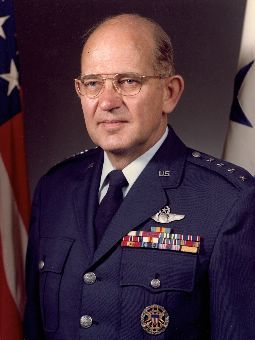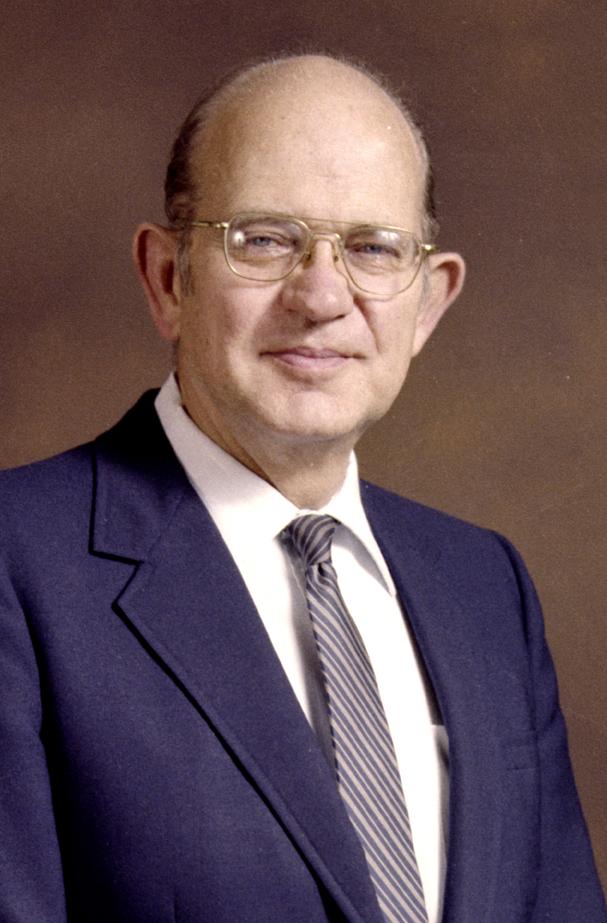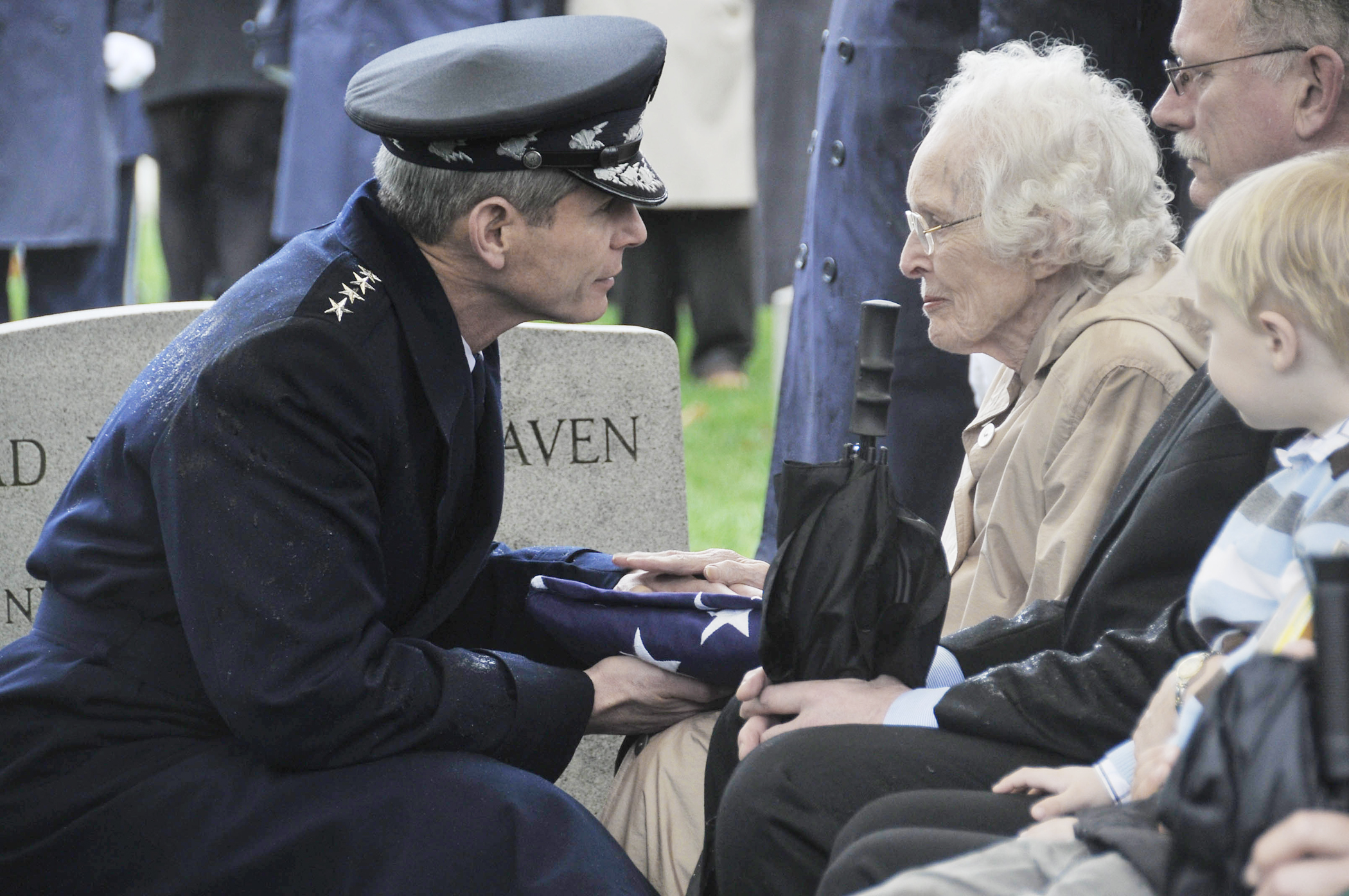GENERAL LEW ALLEN JR.
Retired July 1, 1982. Died January 4, 2010.
General Lew Allen Jr. was the tenth Chief of Staff of the U.S. Air Force and a member of the Joint Chiefs of Staff, Washington, D.C.. As Chief of Staff, he served as the senior uniformed Air Force officer responsible for the administration, training and equipping of a combined active duty, Guard, Reserve and civilian force of nearly one million people serving at nearly 3,000 locations in the United States and overseas. As a member of the Joint Chiefs of Staff, he and the other service chiefs function as the principal military advisers to the secretary of defense, National Security Council and the President.
General Allen graduated from high school in Gainesville, Texas, in 1942. He entered the U.S. Military Academy, West Point, New York, in 1943 and graduated in 1946 with a bachelor of science degree and commission as a Second Lieutenant. He also was awarded pilot wings upon graduation.
After completing multiengine flight training in November 1946, General Allen was assigned to Strategic Air Command’s 7th Bombardment Group at Carswell Air Force Base, Texas, where he flew B-29s and B-36s, and also served in various positions related to nuclear weaponry. He attended the Air Tactical Course at Tyndall Air Force Base, Fla., and returned to Carswell Air Force Base as an instructor and assistant special weapons officer for the 7th Bombardment Wing.
In September 1950 he entered the University of Illinois for graduate training in nuclear physics and received a master of science degree in 1952. He earned his doctorate degree in physics in 1954 after completing an experimental thesis on high energy photonuclear reactions. General Allen then was assigned to the Atomic Energy Commission’s Los Alamos Scientific Laboratory in New Mexico as a physicist in the Test Division. He conducted experiments in several of the nuclear test series. These experiments related to the physics of thermonuclear weapons design and to the effects of high altitude nuclear detonations for ballistic missile defense.
From June 1957 to December 1961, General Allen was assigned to Kirtland Air Force Base, New Mexico, as science adviser to the Physics Division of the Air Force Special Weapons Center. He specialized in the military effects of high altitude nuclear explosions and participated in several weapon test series. He was scientific director of a major experiment that utilized a large series of high altitude rockets to measure the characteristics of electrons trapped in the geomagnetic field after an exoatmospheric nuclear burst.
He was assigned in December 1961, to the Office of the Secretary of Defense, Space Technology Office in the Directorate of Research and Engineering, Washington, D.C. From June 1965 to February 1973, he was assigned to the Office of the Secretary of the Air Force, initially in Los Angeles as deputy director for advanced plans in the Directorate of Special Projects. He moved to the Pentagon in June 1968 as deputy director of space systems and in June 1969 became director. He returned to Los Angeles in September 1970 as assistant to the director of special projects and in April 1971 became director of special projects, with additional duty as deputy commander for satellite programs, Space and Missile Systems Organization.
After serving briefly as chief of staff for Air Force Systems Command at Andrews Air Force Base, Maryland, General Allen was appointed in March 1973 as Deputy to the Director of Central Intelligence for the Intelligence Community in Washington, D.C. In August 1973 he became Director, National Security Agency and Chief, Central Security Service at Fort George G. Meade, Maryland. In August 1977 he was named commander of Air Force Systems Command.
General Allen served as the Vice Chief of Staff, U.S. Air Force from April 1978 until he assumed his present duties in July 1978.
The general is a command pilot with more than 4,000 flying hours, and wears the master missile badge. His military decorations and awards include the Defense Distinguished Service Medal with oak leaf cluster, Distinguished Service Medal (Air Force), Legion of Merit with two oak leaf clusters, Joint Service Commendation Medal and the National Intelligence Distinguished Service Medal. He is a member of the National Academy of Engineering and the Council on Foreign Relations.
He was promoted to General August 1, 1977, with date of rank July 31, 1977.
PASADENA, Calif. — Retired Air Force Gen. Lew Allen Jr., who led the mammoth National Security Agency through a period when congressional scrutiny brought its domestic eavesdropping activities out of the shadows and who later became director of NASA’s Jet Propulsion Laboratory, has died. He was 84.
This March 3, 1983 photo provided by NASA’s Jet Propulsion Laboratory shows Dr. Lew Allen Jr., a former Air Force
chief of staff who headed NASA’s Jet Propulsion Laboratory from 1982 to 1990 and oversaw the launches of the
Magellan spacecraft to Venus and the Galileo mission to Jupiter, died Monday Jan. 4, 2010
in Potomac Falls, Virginia. He was 84. (AP Photo/NASA Jet Propulsion Laboratory)
Allen died on Monday, 4 January 2010, in Potomac Falls, Virginia, according to a NASA statement. A cause of death was not given.
Allen was the first JPL director hired from the outside after a long career in the military and as a spy chief.
In 1973, President Nixon appointed Allen Director of the NSA, at the time a little-known agency responsible for electronic intelligence gathering.
Two years later, testifying before a Senate committee, Allen acknowledged that, at the request of other agencies, the NSA had intercepted the phone calls of Americans. As a result of the hearings, Congress in 1978 passed an act that established a secret court responsible for issuing warrants for domestic wiretapping.
Allen later became Air Force Chief of Staff in 1978, retiring from the service in 1982 as a four-star general.
During his tenure at JPL from 1982 to 1990, he saw the budget for planetary science rebound from an all-time low.
He presided over important robotic space missions including the launches of the Magellan spacecraft to Venus and the Galileo mission to Jupiter. He also oversaw the Voyager 2 flybys of Uranus and Neptune and the completion of a sky survey by the Infrared Astronomical Satellite.
A champion of technology, Allen invested money into research and development projects that eventually allowed scientists to study planets around other stars, said Charles Elachi, the current JPL director.
“He was one of the most visionary people I have ever met, always thinking 10 to 15 years downstream,” said Elachi.
Born in Miami in 1925, Allen attended West Point and joined the Air Force in 1946, flying bombers out of Carswell Air Force Base in Texas. While an Air Force officer, Allen earned a Ph.D. in nuclear physics from the University of Illinois in 1954.
When Allen first came to JPL, people were initially suspicious about a retired general running a civilian space lab, but Allen quickly won them over, said Peter Westwick, author of “Into the Black: JPL and the American Space Program, 1976-2004.”
“When you talk with people anywhere in the military or in the aerospace industry, Allen was really universally respected,” said Westwick, an assistant professor of history at the University of Southern California.
Funeral arrangements were incomplete. Burial will be at Arlington National Cemetery.
Former chief of staff laid to rest at Arlington National Cemetery
23 March 2010
by Master Ssergeant Russell Petcoff
Secretary of the Air Force Public Affairs
The 10th chief of staff of the Air Force was laid to rest in a full-honors ceremony March 22 at Arlington National Cemetery, but his legacy lives with today’s Airmen through his emphasis on developing camaraderie, pursuing history and recognizing excellence.
General Lew Allen Jr. passed away January 4, 2010, in Potomac Falls, Virginia. He served as chief of staff from July 1978 to July 1982.
The general left an indelible mark on the Air Force, whether it’s singing the “U.S. Air Force Song,” knowing airpower history or receiving one of the annual awards named in his honor.
“The ‘Army Air Corps’ song was originally written by Robert Crawford in 1939 and selected by Major General Henry “Hap” Arnold, chief of the Army Air Corps, as the official song,” wrote Brigadier General H.J. Dalton Jr., director of information, in a 1978 staff summary sheet to designate it as the official Air Force song. General Allen made it official with a memorandum dated September 27, 1979.
“The United States Air Force inherited many fine traditions from the Army Air Corps,” General Allen wrote. “Among these was the song ‘The Army Air Corps.’ Although this song was retitled ‘The U.S. Air Force’ in 1947, there was no accompanying formal action to adopt the song or secure a copyright release for its use. Recently, however, the copyright holder very generously granted the Air Force permission to designate ‘The U.S. Air Force’ as its official song. Thus, I hereby declare that ‘The U.S. Air Force,’ popularly known as ‘Off We Go Into The Wind Blue Yonder,’ to be the official song of the Air Force. In keeping with our tradition, let us stand proudly when it is played or sung.”
His interest in tradition led him to encourage Airmen to study the past to understand today. General Allen created Project Warrior September 1, 1982, as a professional development program to help Airmen better understand and apply airpower and warfare history. Project Warrior was a voluntary program for base units to develop as they saw fit “to create and maintain an environment for Air Force people to think and plan in warfighting terms,” wrote F. Clifton Berry Jr, in August 1982. Mr. Berry was Air Force Magazine’s editor in chief in August 1982.
“General Allen told Air Force Magazine just before he retired that Project Warrior ‘is an informal, voluntary program that units can tailor to their own organization and their own interests,'” added Mr. Berry. “He went on to say, ‘In general, we are trying to inspire in our people a desire to understand more and to explain better how airpower really contributes to modern warfare.'”
“Project Warrior seeks to create and maintain within the Air Force an environment where Air Force people at all levels can learn from the past and apply the warfighting experiences of past generations to the present,” wrote General Allen’s successor, General Charles A. Gabriel, 11th chief of staff, in 1984 in a foreword to “The Literature of Aeronautics, Astronautics, and Air Power.”
“When General Lew Allen, Jr. initiated this project in 1982, he called for the ‘continuing study of military history, combat leadership, the principles of war and, particularly, the applications of air power.’ All of us in the Air Force community can benefit from such study and reflection. The challenges of today and the future demand no less,” General Gabriel continued.
Major David W. Keith wrote “The Warrior and the Pachyderm” in the January-February 1984 issue of Air University Review about Project Warrior. “Through Project Warrior, General Lew Allen challenged everyone connected with the Air Force to become serious students of how to fly, fight and, by the way, win,” wrote Major Keith. “Technical skill alone will not hack it anymore, he indicated, because modern war is complex; it is interrelated. Because it is interrelated, technical expertise confined to one specialized field is simply not enough.”
General Allen’s heritage also lives on in two awards bearing his name. An Air Force award in General Allen’s name is presented annually to a base-level officer and senior NCO in aircraft, munitions or missile maintenance directly involved in aircraft sortie generation. According to officials, the award was established as a tribute to General Allen’s focus on attention to detail and technical expertise, attributes reflected in the nominees honored.
The other award named after him is at the Jet Propulsion Laboratory. Following his retirement from the Air Force in July 1982, General Allen became director of the Jet Propulsion Laboratory National Aeronautics and Space Administration Center in Pasadena, California, and remained in that position until 1990. The Lew Allen Award for Excellence recognizes significant accomplishments, leadership in scientific research, or technological innovation, in the early years of an individual’s professional career, according to JPL.
Following announcement of his death in January, readers of the obituary on www.af.mil described the type of Airman the general was.
“I retired from the (Air Force) in 1981,” wrote Bill Woleslagle of Woodbridge, Va. “My last duty assignment was with the 2044th (Communications Group) in the Pentagon. I met General Allen several times in the old (National Military Command Center). Mr. Woleslagle added General Allen was “a very intelligent and down-to-earth man.”
One anonymous Airman recalled meeting the general early in his Air Force career.
“As a new Air Force 2nd (lieutenant), I had a chance to meet him at a dining in at Loring AFB, Maine,” wrote the anonymous reader. “He was wonderful to all of us ‘butterbars’ when we got brave enough to approach him during the pre-dinner festivities.”
Military members, retirees and family members gathered at General Allen’s final resting place to pay their last respects.
Among those in attendance were Gen. Norton Schwartz, Air Force chief of staff; as well as General Allen’s wife Barbara and family.
The full-honors funeral continued with a three-volley salute and Taps despite heavy rains. As the funeral drew to a close, General Schwartz presented Mrs. Allen with a folded flag on behalf of the Air Force and took a moment to offer a few words of condolence.
General Norton Schwartz, chief of staff of the Air Force, presents a folded flag to Barbara Allen, wife of General Lew Allen Jr.
Michael Robert Patterson was born in Arlington and is the son of a former officer of the US Army. So it was no wonder that sooner or later his interests drew him to American history and especially to American military history. Many of his articles can be found on renowned portals like the New York Times, Washingtonpost or Wikipedia.
Reviewed by: Michael Howard



